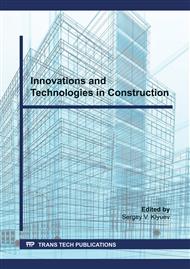p.81
p.91
p.101
p.111
p.123
p.133
p.143
p.153
p.163
Comparative Resistance of Concrete with Aggregates and Fillers of Different Composition
Abstract:
The paper studies the influence of aggregates and fillers with negative and positive electrical surface properties on the corrosion resistance of concrete. The advantage of resistance of fine-grained concrete on marble sand in comparison with concrete on quartz sand, regardless of the type of aggressive environment, is established. At the same time, the stability of samples of powdered concrete with 10 and 30% of fine-grained filler changed little when replacing the quartz powder with marble one. It is shown that the resistance coefficients of powdered concrete samples with quartz filler (10%) do not differ from the resistance coefficients of samples of a similar composition with crushed marble filler, and with an increase in the dosage of the filler (30 %) slightly exceed. It was found that in powder concretes without aggregates, the contact layer between the cement matrix and the aggregate is absent, so the composition of the mineral powder plays a much smaller role in the corrosion processes of cement stone. The obtained results allowed establishing that electrokinetic phenomena play a secondary role, and the main influence on the stability of fine-grained concrete is the processes of pore colmation by chemical reactions, as well as the interaction of the surface layers of the aggregate with the cement matrix.
Info:
Periodical:
Pages:
133-142
Citation:
Online since:
January 2021
Price:
Сopyright:
© 2021 Trans Tech Publications Ltd. All Rights Reserved
Share:
Citation:


